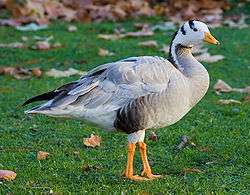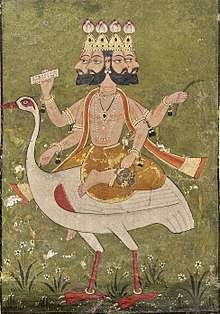Hamsa (bird)
The hamsa (Sanskrit: हंस, haṃsa or hansa) is an aquatic bird of passage, which various scholars have interpreted as the goose, the swan,[2] or even the flamingo.[1][3] Its icon is used in Indian and Southeast Asian culture as a spiritual symbol and a decorative element. It is believed by Hindus to be the vahana (or vehicle) of Brahma, Gayatri, Saraswati, and Vishvakarma.[3]

.jpg)
Identification
Monier Williams translates the term from Sanskrit as "a goose, gander, swan, flamingo (or other aquatic bird, considered as a bird of passage ...)."[1] The word is also used for a mythical or poetical bird with knowledge. In the Rig Veda, it is the bird which is able to separate Soma from water, when mixed; in later Indian literature, the bird separates milk from water when mixed.[1] In Indian philosophical literature, hamsa represents the individual soul or spirit (typified by the pure sunlight-white like color of a goose or swan), or the "Universal Soul or Supreme Spirit".[1]
The word Hamsa is cognate with Latin "(h)anser", Greek "χήν", German "Gans", English "goose", Spanish "ganso" and Russian "гусь".[4]
Jean Vogel, in 1952, questioned the identification of hamsa as swan, because swans were rare, at least in modern India, while the bar-headed goose (Anser indicus) were somewhat common.[5] Some have criticised Vogel's view as being over-reliant on artistic representations from south India and Sri Lanka, where the white swan is rare. According to Vogel, Western and Indian scholars may have preferred translating hamsa in Sanskrit text as swan because the indigenous goose appears plump while the swan (and, Vogel adds, the flamingo) appears more graceful. Vogel also rules out the ruddy shelduck which is unambiguously referred to in Sanskrit as Chakravaka.[5]
The Sanskrit and Pali languages, both have alternate words for goose such as Jalapada, Dhamara, Cakragki, Majjugamana, Shvetagaruta and others.[6][7]
Dave states that the hymns of Rigveda, and verses in Hindu Epics and Puranas mention a variety of birds with the root of hamsa (हंस), such as Maha-hamsa, Raj-hamsa, Kal-hamsa and others, most of which he identifies as swans particularly mute swan, while some refer to geese.[8] Dave's identification is based on the details provided in the Sanskrit texts about the changes in plumage over the bird's life, voice, migratory habits, courtship rituals and flying patterns.[8] Dave cites several Sanskrit works from the Ṛgveda onwards that unambiguously identify the haṃsa as a bird of snowy white plumage. Dave notes that the breeding grounds of various types of swan range from the Caspian to Siberia and Western Turkestan, and that they are seen mainly in Sind, Panjab and sometimes in Nepal and Rajasthan. Some Sanskrit texts, states Dave, distinguish between Hamsa and Kadamb, the former being swan and latter a bar-headed goose.[8] The Indian ornithologist Salim Ali noted that Raghuvira's (with whom Dave worked) identifications of birds in Sanskrit literature were dubious and often far-fetched. Ali considered Raj-hamsa as the bar-headed and Kadamb as the greylag goose.[9]
However, the earliest art in India, up until the early colonial period, does not depict swans, but rather birds that resemble the bar-headed goose. Hence, the birds painted at the Ajanta Caves in the depiction of the Hamsa Jataka resemble the bar-headed goose,[10] which are famous for their yearly migration into the Himalayas, while the text of the Jataka itself clearly describes white swans that are like clouds in a blue sky.
In Hinduism
The hamsa is often identified with the Supreme Spirit, Ultimate Reality or Brahman in Hinduism.[2] The flight of the hamsa symbolizes moksha, the release from the cycle of samsara.[11][12]
The hamsa is also the vahana of Saraswati – the goddess of knowledge and creative arts, and her husband Brahma – the god with powers of creation, in Hindu trinity and his other wife Gayatri - the goddess of vedas(vedmata), one of Adi shakti and her other husband Vishvakarma - the god of Architect.[3][11]
Lake Manasarovar in Hindu mythology, is seen as the summer abode of the hamsa. Poetical images are derived from the flight of the hamsa to that lake in the Himalayas.[13]
Yoga
During pranayama, which is a yogic exercise of breath control, hamsa came to epitomize the prana, the breath of life.
Paramahamsa
In view of the association of a hamsa with several attributes as indicated above, Hindu rishis and sadhus have been given the title of paramahamsa, that is, the supreme hamsa. It connotes a particular person who has reached a high level of spirituality.[14][15]
For example, Paramahamsa Upanishad calls that Yogi a Paramahamsa who is neither opinionated nor affected by defamation, nor jealous, not a show off, is humble, and is oblivious to all the human frailties. He is immune to the existence of his body, which he treats as a corpse. He is beyond false pretensions and lives realizing the Brahman. In chapter 3, the Paramahamsa Upanishad states that the one who understands the difference between "staff of knowledge" and "staff of wood", is a Paramahamsa.[15]
He does not fear pain, nor longs for pleasure.
He forsakes love. He is not attached to the pleasant, nor to the unpleasant.
He does not hate. He does not rejoice.
Firmly fixed in knowledge, his Self is content, well-established within.
He is called the true Yogin. He is a knower.
His consciousness is permeated with that, the perfect bliss.
That Brahman I am, he knows it. He has that goal achieved.
Mythology
Hamsa, or Hansa, are part of Indian mythology. Arayanna, or heavenly hamsa (swans), are said to live in Manasasaras in the Himalayas.[18] They are mentioned in the Hindu Epic, the Ramayana.[18] Hamsa, the swan, is part of the mythical love story of Nala and Damayanti, where it carries the stories, historical information and messages between the two strangers.[18]
In Indian mythology, it is said to eat pearls and separate milk from water from a mixture of both.[19]
Eastern Religious scholar, Alan Watts, stated that the Hindu tradition includes a myth regarding half a Hamsa's eggshell becoming the sky and the other half becoming the earth. A similar egg-sky-earth cosmological story can be found in the Finlandic myths recorded in the Kalevala, where the eggshell of a duck forms the sky and earth.
Buddhism
The hamsa was also used extensively in the art of Gandhara, in conjunction with images of the Shakyamuni Buddha. It is also deemed sacred in the Buddhadharma.
Contemporary usage
The name in other languages in which it is culturally important are Hindi: hans, Telugu: హంస, hamsa Tamil: அன்னப்பறவை; Khmer: ហង្ស, hong; Burmese: ဟင်္သာ, IPA: [hɪ́ɰ̃θà], and commonly spelt hintha or hinthar; Mon: ဟံသာ (ၜိုပ်), [hɔŋsa] or hongsa; Shan: ႁင်းသႃႇ, [haŋ˦ sʰaː˨] or hangsa; Thai: hong (หงส์), [hǒŋ]; Malay: angsa (اڠسا).
The hintha (hamsa) is widely depicted in Burmese art, considered to be "swan" in its mythology, and has been adopted as the symbol of the Mon people.[21][22]
- Hamsa border on the Kanishka casket, 2nd century CE
- Hamsa birds between the architectural spires on the Bimaran casket, 1st century CE
 God Brahma on hamsa (~1700 CE)
God Brahma on hamsa (~1700 CE) Hamsa with goddess Saraswati (Indian painting, 19th century)
Hamsa with goddess Saraswati (Indian painting, 19th century) Goddess Saraswati riding hamsa (Indonesian sculpture, 20th century)
Goddess Saraswati riding hamsa (Indonesian sculpture, 20th century) Hamsa talking to Damayanti in Hindu mythology
Hamsa talking to Damayanti in Hindu mythology
See also
| Wikimedia Commons has media related to Hamsa. |
References
- Monier Monier-Williams, Monier Williams Sanskrit Dictionary, हंस, Hamsa, University of Cologne, Germany, ISBN 978-8120615090, page 1286
- Lindsay Jones (2005), Encyclopedia of religion, Volume 13, Macmillan Reference, ISBN 978-0028657332, page 8894, Quote: "In Hindu iconography the swan personifies Brahman-Atman, the transcendent yet immanent ground of being, the Self."
- Denise Cush (2007), Encyclopedia of Hinduism, Routledge, ISBN 978-0415556231, page 697
- J. Pokorny, Indogermanisches etymologisches Wörterbuch. *ĝhan-s-
- Jean P Vogel, The Goose in Indian Literature and Art (Arts & Letters, Vol. XXVII, 1952; Reprinted Leiden, 1962), pages 1–2
- Maung Tin, Pali English Dictionary, British Burma Press, Cornell University Archives
- Monier Monier-Williams, Monier Williams Sanskrit Dictionary. See Goose, University of Cologne, Germany, ISBN 978-8120615090
- Dave, KN (2005). Birds in Sanskrit Literature. Motilal Banarsidass. pp. 422–447. ISBN 978-8120818422.
- Ali, S. (1979). Bird study in India: Its history and its importance. New Delhi: ICCR.
- https://web.archive.org/web/20171211151602/http://ignca.nic.in:80/jatak002.htm
- John Bowker (1998), Picturing God, Series Editor: Jean Holm, Bloomsbury Academic, ISBN 978-1855671010, pp 99-101
- Richard Leviton (2011), Hierophantic Landscapes, ISBN 978-1462054145, pp 543
- Kalidasa's maha-kavya Raghuvaṃśa
- Deussen 1997, pp. 717-720.
- Olivelle 1992, pp. 137-140.
- Deussen 1997, pp. 753-755.
- "परमहंसोपनिषत्". sanskritdocuments.org. p. ॥ ४॥, verse 4. Retrieved 7 January 2016.
- George Williams (2001), Handbook of Hindu Mythology, ISBN 978-1576071069, pages 58-59
- Helen Myers (1999), Music of Hindu Trinidad: Songs from the India Diaspora, University of Chicago Press, ISBN 978-0226554532, page 4
- British Museum Collection Bird, probably a goose, carved in rock crystal.
- Sylvia Fraser-Lu (1994), Burmese Crafts: Past and Present, Oxford University Press, ISBN 978-0195886085, page 116
- Robert Reid and Michael Grosberg (2005), Myanma (Burma), ISBN 978-1740596954, page 140
- Dictionary of Hindu Lore and Legend (ISBN 0-500-51088-1) by Anna Dallapiccola
- Deussen, Paul (1997). Sixty Upanishads of the Veda. Motilal Banarsidass. ISBN 978-8120814677.CS1 maint: ref=harv (link)
- Olivelle, Patrick (1992). The Samnyasa Upanisads. Oxford University Press. ISBN 978-0195070453.CS1 maint: ref=harv (link)
